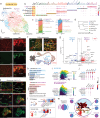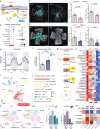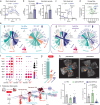Metabolic reprogramming of the neovascular niche promotes regenerative angiogenesis in proliferative retinopathy
- PMID: 40562775
- PMCID: PMC12198394
- DOI: 10.1038/s41467-025-60061-4
Metabolic reprogramming of the neovascular niche promotes regenerative angiogenesis in proliferative retinopathy
Abstract
Healthy blood vessels supply neurons to preserve metabolic function. In blinding proliferative retinopathies (PRs), pathological neovascular tufts often emerge in lieu of needed physiological revascularization. Here we show that metabolic shifts in the neovascular niche define angiogenic fate. Fatty acid oxidation (FAO) metabolites accumulated in human and murine retinopathy samples. Neovascular tufts with a distinct single-cell transcriptional signature highly expressed FAO enzymes. The deletion of Sirt3, an FAO regulator, shifted the neovascular niche metabolism from FAO to glycolysis and suppressed tuft formation. This metabolic transition increased Vegf expression in astrocytes and reprogrammed pathological neovessels to a physiological phenotype, hastening vascular regeneration of the ischemic retina and improving vision. Hence, strategies to change the metabolic environment of vessels could promote a regenerative phenotype in vascular diseases.
© 2025. The Author(s).
Conflict of interest statement
Competing interests: The authors have no conflicts of interest to declare relevant to this article’s content. F.R. is an advisory board member for Bayer AG (Germany) and F. Hoffmann-La Roche AG (Switzerland). P.S. is the founder and Chief Scientific Officer of SemaThera Inc. (Montreal, Canada) and Chief Scientist of UNITY Biotechnology (California, US) and holds equity in both companies.
Figures






References
MeSH terms
Substances
Grants and funding
LinkOut - more resources
Full Text Sources
Molecular Biology Databases

